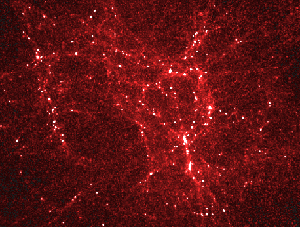|
5:00 p.m., March 12, 2003--A University of Delaware professor is included in a team of astrophysicists that reports in the March 7 issue of the journal Science that they have calculated the rate of helium production by stars in our universe with greater precision than ever before.
 |
| This illustration shows how our universe might have looked when it was just a fraction of its current age, and gravity formed galaxies from long filaments of mass. Credit: F. Summers (Princeton), D. Cox, R. Patterson, E. Wesselak, and B. Sanders (NCSA), L. Carpenter (Pixar), GC3, Cosmic Voyage, Smithsonian. |
This better understanding of stellar helium production brings new insights into the composition of the early universe and could help determine the exact nature of dark energy.
The team includes Raul Jimenez, assistant professor of physics and astronomy at the University of Pennsylvania; James MacDonald, professor of physics and astronomy at the University of Delaware; Chris Flynn of the Tuorla Observatory in Finland; and Brad K. Gibson of Swinburne University in Australia.
“Helium represents 27 to 30 percent of the matter in the universe today, but our work indicates that 14 billion years ago it was just 24 to 25 percent of matter in the primordial universe,” Jimenez said. “We found that metal-rich stars in our universe produce roughly 2.1 times as much helium as metals, leading to this cosmic enrichment.”
The rate at which cosmic helium is produced relative to metals is of great interest to astrophysicists and cosmologists. The ratio governs how long stars live. It's also an important variable in determining the age of galaxies, which in turn factors into equations describing the mysterious, as-yet-unobservable dark energy now believed to comprise some 73 percent of the universe's mass. As a result, Jimenez said, these findings could help better define dark energy.
Tracking the production of helium in the cosmos is a daunting task, accomplished in this case by observing helium's indirect effect on the temperature of stars whose metallicity is known and whose temperature is not affected by their age.
The team used spectroscopic analysis of K dwarf stars–smaller than the sun and no more than 8,000 degrees Kelvin–to determine the amount of helium being emitted. They also used measurements of star distance and star luminosity, a factor that hints at the amount of metal in a star, from the European Space Agency's Hipparcos satellite.
“In examining these Hipparcos stars, we encountered what we called a 'Goldilocks effect,’” Jimenez said. “Some of the 10,000 stars whose luminosities have been measured by Hipparcos were too hot for us to analyze, and some were too cool. We studied 31 K dwarfs that were suitable.”
Three minutes after the Big Bang, when the cosmic temperature was one billion degrees Kelvin, protons and neutrons combined to form the nuclei of the lightest elements, including helium. About a hundred million years later, stars began to form, all of them recycling helium into the surrounding cosmos from which new stars can form. Stars rich in helium burn hotter and more brightly and are therefore shorter-lived than more metal-rich stars.
Previous theoretical estimates had suggested that helium is now produced by stars at anywhere from one to three times the rate of metal production. Through their observations, Jimenez and his colleagues have now refined this figure to 2.1 +/- 0.4. Because stars generate metals, which were not present in the early universe, these elements now comprise about 2 percent of the baryonic matter in the universe.
For his part in the project, MacDonald provided the computer calculations that give the predicted luminosity and surface temperatures of the stars. “These quantities depend mainly on the mass of the star, its helium content (the fraction of the mass of the star that is in the form of helium) and the ‘metal’ content (the fraction of the mass of the star that is in the form of elements other than hydrogen and helium),” he said. “The observations tell us the luminosity, surface temperature and the ‘metal’ content. Hence a comparison of theory and observations allows us to determine the mass of the star and the helium content.”
The calculations are not difficult and are done by other researchers, MacDonald said, however Jimenez has found the UD professor’s results best at fitting the observations of stars less massive than the sun.
The National Science Foundation, Australian Research Council, Discovery Project and Linkage International Award and Academy of Finland support the work of the research team.
Article by Neil Thomas
|

